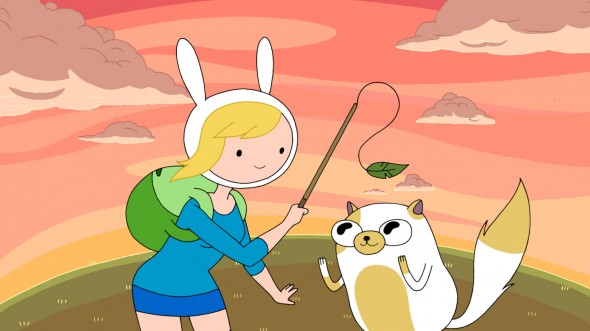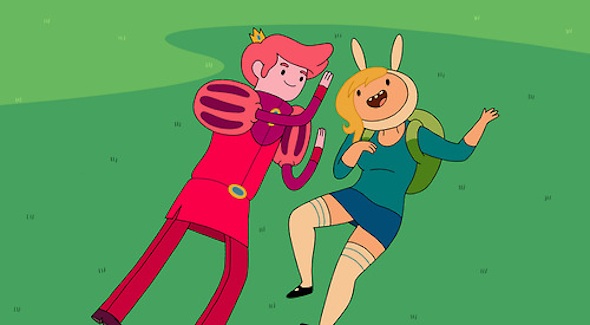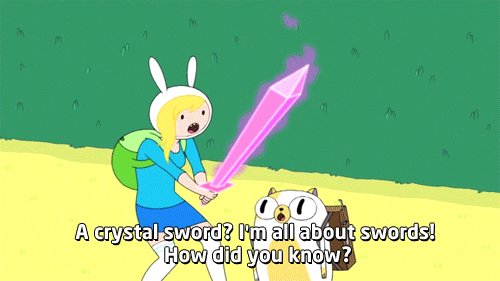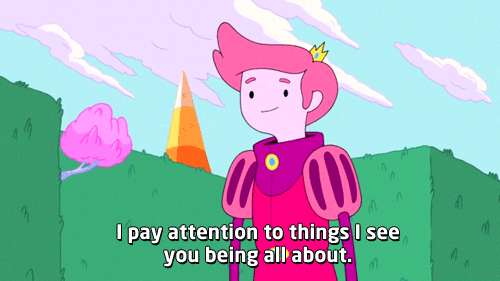Adventure Time, as you may know if you’ve been on the Internet at least once in the last six years, is a show on Cartoon Network (ostensibly for kids in the same way that Invader Zim and much of Animaniacs was for kids, in that it is in large part wildly inappropriate for kids). Following the exploits of Jake the Dog and Finn the Human, it takes place in the Land of Ooo – a techno-magically batstuff-insane continent on an Earth one thousand years after a devastating apocalypse known as “The Great Mushroom War.” It’s funnier than it sounds. I still think it’s generally more sad than funny, overall, which is in itself actually a hell of an achievement – kids’ shows with genuine pathos are pretty rare, since the end of Fraggle Rock – and thus there’s a lot to overthink up in there (although now that I do a search, OTI hasn’t got any articles on the show until this one, so maybe I’ll write some other stuff if you guys are interested).
It’s currently in its fifth season, and though I started watching it a while ago, it took me some time to really get into it; now, though, that I’ve grokked its logic, I’ve been on something of an archive binge. There was one episode in the third season wherein all the characters in the show are gender-swapped – Finn the Human Boy becomes Fionna the Human Girl, and Jake the Dog becomes Cake the Cat (which is an adorable name for a cat, if any of you have new kitties in need of a good moniker).

As I watched the episode, I was at first intrigued, then increasingly alarmed, and finally alarmingly intrigued (as per G.W.F. Hegel’s dialectic of watching cartoons). By reversing the sexes of Ooo’s inhabitants, Adventure Time made a statement about gender roles that was at once insightful and deeply problematic. As a person with a gender, I feel that I am qualified to comment on this, while I try to work out some of the implications of how Finn/Fionna and Jake/Cake were characterized, the similarities and differences, and the overall message (if any) that the episode made on both the diegetic and meta-levels.
The episode starts out without any explanation for the change – it’s just that all the characters are now the opposite sex, and at first we only see the visual similarities and differences. Fionna wears blue, just like Finn. Finn, at this point, is supposed to be around thirteen, but Fionna seems rather older – whether that’s because Fionna actually is older than Finn, or just that female humans typically develop sooner than males is left ambiguous
The complications begin when Prince Gumball – the gender-swapped version of Princess Bubblegum – asks Fionna to accompany him to the Biennial Gumball Ball. Now, Prince Gumball is pink from head to toe, just as Princess Bubblegum is, which matches with Fionna’s remaining dressed in blue. The stereotypical colours for boys and girls, which Finn and Bubblegum respectively exhibit – aren’t transposed for the gender-swap. Genital pun aside, Prince Gumball’s penchant for baking seems to be the equivalent of Princess Bubblegum’s scientific genius – both are interests that go against the stereotypes of what men and women are “supposed” to be like, but neither of which are used within the show to portray the characters as unfeminine, in Bubblegum’s case, or unmasculine, in Gumball’s. Nobody tells Princess Gumball that she shouldn’t be doing science because of her gender (and they’d be dumb to tell her that, anyway – she invented a potion to resurrect people from the dead!). Fionna, on the other hand, is referred to, at one point, derisively as a “tomboy” by the Ice Queen (whom, you can probably guess, is the gender-swapped version of the Ice King in the regular world).
So while Fionna is shown to have certain “masculine” traits (she’s no less inclined to use violence to solve problems that her male counterpart Finn – and, to be fair, in the world of Adventure Time, when Finn uses violence to solve the problem of the week, it does usually work. Fionna is also just as fond of cool swords as Finn; she’s super psyched to receive a retractable crystal sword from Prince Gumball, and less impressed at the bouquet of flowers he also gives her), Finn is not portrayed as entirely un-“feminine” either; he loves to dance, which is not exactly stereotypical for a 13-year-old boy, and his first instinct is frequently to punch people, but at the same time he’s gained somewhat of a reputation for crying all the time. He insists that he only cries when it’s appropriate – like when people die – but nevertheless, crying is something that Finn does numerous times throughout the show, and while he’s sensitive about it when called out, when he is actually sad enough to cry, Finn doesn’t appear embarrassed to do it when other people are around. Not typical behavior for a male character or a “hero,” but something that makes the trade-off with Fionna’s perceived “ungirliness” appear at least fair.
Finn nearly always wears this white hat that covers most of his head (everything but his face, really), and with bear ears at the top. Fionna wears a similar hat, with two differences: at the top are bunny ears instead of bear ears, and Fionna’s hair visibly protrudes from under the hat. Now, whether or not a bunny is a more “feminine” animal than a bear is, I guess, debatable; but it’s a long-standing trope in animation that females can be virtually identical to males except with long hair and, often, eyelashes. When Finn’s hat is off, we can see that he has long blonde hair of the same sort as Fionna, but he always makes an effort to conceal it, whereas we can clearly see Fionna’s hair at all times. Fionna’s hair is longer than Finn’s at the point when this episode occurs, but this may not be an issue – the first time we ever see Finn without his hat, his hair is practically down to his feet, we get the sense that he’s never had a haircut in his life. He cuts off all his hair at the end of that episode, and the length it is during the Gender Swap episode seems like it’s just the length it would naturally have grown to during the intervening period.

So far, pretty much so good.
Those are the visible character-design type of differences, but there’s also a meta-casting issue. The voice actors who were chosen to play some of the gender-swapped characters can give us some insight into how we are meant to understand the frame of these characters, because both the actor who plays Fionna, and the one who plays Prince Gumball, are meaningful choices in that they are associated with other roles wherein sexuality and gender are main themes.
Fionna is played by Madeline Martin, best known for playing Becca on Showtime’s Californication. Becca’s father is Hank Moody (David Duchovny), a sex-addicted novelist whose womanizing consistently traumatizes his daughter. Despite Hank’s having the best intentions, his behavior toward women is shown to negatively inform Becca’s ideas about sexuality and romantic relationships throughout the series.
Prince Gumball is played by Neil Patrick Harris, a gay man who is best known for portraying very exaggeratedly heterosexual characters, such as Barney Stinson on How I Met Your Mother, and a fictionalized version of himself in the Harold and Kumar movies, who’s unusually fond of drugs and ladies. He was also the eponymous character is Joss Whedon’s Doctor Horrible’s Sing-Along Blog, another heterosexual romance story with a plot that was also partly driven by songs, like this episode of Adventure Time. Smart casting, too – NPH can sing.
The point at which I started becoming uncomfortable with this episode was when it became obvious that the plot was going to be a romantic one. The main narrative revolves around Fionna being asked out on a date by Prince Gumball, Fionna spending a lot of time freaking out and preparing for it, then the events of the date itself, until at last it’s revealed that “Prince Gumball” was actually the Ice Queen in disguise, who had captured the real Prince Gumball in order to lure Fionna and eliminate her – as Fionna is the one who constantly foils the Ice Queen’s plans to kidnap and marry a Prince (as her regular-world counterpart, Ice King, is obsessed with marrying a Princess). As Fionna puts it, “Ice Queen, why you always gotta be predatoring on dudes?”
The thing is that this sort of story could never happen between the original-gendered Finn and Princess Bubblegum. It’s not that the regular world is devoid of romance – as a matter of fact, for much of the series Finn is totally in love with Princess Bubblegum. But much is made of the fact that his feelings toward her are not reciprocated, in large part because he is far too young for her. At one point when Finn tries to make a move, and is rejected (Princess Bubblegum tells him to “stop being weird”), Finn spends most of the rest of that episode uncontrollably weeping, literally paralyzed with misery that is in no way played for laughs. But in the gender-swapped world, we’re meant to believe that Prince Gumball’s interest in Fionna is reciprocated, despite the fact that seemingly everything else is the same. Why?


It could be the apparent age difference: Fionna looks and acts older than Finn, so maybe she’s actually closer in age to Prince Gumball than Finn is to Princess Bubblegum. Certainly the Princess was more receptive to Finn when she was (briefly) transformed into a 13-year-old. But all other things being equal, why would Fionna logically be older than Finn? It’s clearly a writing issue: they wanted the possibility of a relationship between Fionna and Gumball, but with Gumball at 18 and Fionna at 13 it would seem inappropriate to say the least. The idea that Fionna would have a crush on Gumball in the same way that Fionna does on Bubblegum is plausible enough, but in order for the interest to be reciprocal they needed to age Fionna. This seems like uncharacteristically poor storytelling for Adventure Time, though: why shoehorn a romance plot into an episode where the whole point is reversing character’s genders, unless you’re trying to reinforce the stereotype that the primary driving force for female characters must be their romantic relationships? That’s what bugged me the most, as I was watching the episode – given this one chance to investigate what the life of a female version of Adventure Time’s hero would be like, they decided to make it all about her being wooed by a dreamy Prince.
This isn’t really solved by the fact that “Prince Gumball” was actually the Ice Queen in disguise, either; because after Fionna discovers the ruse, defeats the Ice Queen and rescues the real Prince Gumball, Gumball immediately reacts to Fionna’s heroism by asking her to be his girlfriend for realsies. And she declines, deciding that she doesn’t actually want a boyfriend at all. Which pretty much contradicts everything we’ve learned about Fionna throughout the episode, plus what we’ve been able to infer based on what we know about Finn.
The other thing that really shocked me, where the show seemed to be going out of its way to reinforce stereotypes rather than subvert them, is at one point near the very end of the episode, after Fionna has defeated the Ice Queen and saved Prince Gumball, Cake enters the room – Cake sees Fionna with her clothes all torn from the battle with Ice Queen, and instantly assumes that Prince Gumball had tried to assault her; it’s perfectly understandable that Cake would be unusually protective of her best friend and adoptive sister Fionna, but at the same time she would know better than anyone that Fionna could easily beat the lumping fructose out of Gumball if he tried anything untoward. Fionna corrects Cake’s misunderstanding right away, but Cake’s assumption still kind of rankled.
So what’s going on here?
The end of the episode is a typically atypical Adventure Time “reveal” that appears to resolve things while actually only complicating them further – in the best kind of way.
No sooner has Fionna declared that she’s happy being single than she contradicts herself, saying that she’d love to date the Ice King. Remember that the Ice King doesn’t even exist in this universe! All the other ladies assembled immediately echo Fionna’s sentiments, and the audience is super confused…until we cut to the regular Adventure Time world, to the Ice King’s castle, where he has Finn and Jake imprisoned.
And it turns out that the entire episode has been a piece of fan fiction, written by the Ice King, that he’s reading to Finn and Jake.
Which suddenly turns everything on its head. The unease that I felt at Fionna being shoehorned into a romantic plot now seems like a deliberate attempt to invoke that particular trope – the young woman who’s incomplete until her Prince arrives – and subvert it. Because it then pulls back to show us the kind of person who deploys this trope unironically: that is, a crazy old man with big problems of his own. At the same time it’s commenting on the phenomenon of fandom in general, “shippers,” and “Rule 63” in particular – the Internet law which states that “for every fictional character, someone will create a counterpart character of the opposite sex.”
Fionna’s origin (in the real world, that is, our extradiegetic world) is that they were created by Natasha Allegri, one of the character designers on Adventure Time, as sort of a joke. When Pendleton Ward (Adventure Time’s creator) saw the drawings, he thought they were great and this eventually culminated in the gender-swapped episode.
That seems to make the whole episode simpler – that it’s just kind of a joke at the shippers and Rule sixty-three-ers expense, by making the Ice King their stand-in, with all the baggage he comes with – but actually it’s much more than that. “Adventure Time with Fionna and Cake” let the creators mess around with gender, invoke stereotypes and tropes of gender roles while at the same time subverting them, simultaneously delight and annoy its viewers by forcing them to confront those stereotypes (e.g. viewers who were unnerved by the stereotypes throughout the episode get to be redeemed by the episode’s ending, while the ones who enjoyed them have thirty seconds to feel ripped off and maybe vaguely offended by being compared to the Ice King), while also making an obscurish inside joke about Internet culture with a subtle jab at fan fictionalists that nevertheless caters to them with a full episode of unadulterated fanservice!
Whew!
In other words, the episode allowed the people behind Adventure Time to magically have their Candy Kingdom and eat it too.
What’s absurd about Adventure Time is that most of what is being Overthought about it here is entirely the intention of the writers (with the possible exception about the meaning of the casting).
So just thinking as opposed to overthinking.
Who Overthinks the Overthinkers?
Oh, yay! Richard, I was so excited when I heard you were going to overthink Adventure Time, and this article didn’t disappoint.* One thing that adds another layer of interest to this discussion is the fact that Fionna’s bunny hat is a direct reference to Sailor Moon, who in the Japanese version is named Usagi (“bunny” in Japanese) and who also has a sassy talking cat. The writers are doing both a parody of Adventure Time (but gender-flipped) as well as a parody of magical girl anime shows (and perhaps fan-fiction based on those types of shows).
ARGH I NEED TO OVERTHINK ADVENTURE TIME SO BADLY
*In fact, I would label it “mathematical.” “Rhombus,” even.
I second the part in all caps. Where the heck have you been!?!?!?
Writing books lol – everyone follow @shanamlawski so i can subtly promote myself to you
But about the Luna/Cake parallel, I do think it’s interesting that it’s quite more common for female characters to have feline companions, while male have canine ones.
If we think about the “social structures” of the two types of animals in the wild, though, the results are rather even. There are examples of both pack and individual organizations for each in terms of structure (or lack thereof). But in either type, when it’s a group setting, the main leader of a particular unit is male. But there’s a strict reversal in role from traditional human organization- wolf or lion packs, for example, have a male leader, sure, but the females to the hunting; with humans, the males hunt. But in both cases, females still rear offspring.
Back to Sailor Moon: in the original Japanese version of Sailor Moon, Luna’s voice is younger than her dubbed version- she’s more like a peer to Usagi, and her dialogue is less condescending and more empathetic. She does still have a baby (in the future…) with Artemis, which helps to fulfill that maternal role.
I’ve been told to watch Adventure Time by a lot of friends. But I haven’t. (Don’t eat me!) So I’m going to ask, does Jake’s voice sound like he’s a kid, or an adult? Is he the one imparting knowledge onto Finn, or are they both learning at the same rate? (I’m assuming they’re both learning, regardless, just wondering if perhaps it’s in different ways.)
And the reason I think this is important is because if we think about the natural environment and fulfilling gender roles, and if we latch onto the child-rearing role in particular, females with cats and males with dogs is the logical follow-up. But the hunting aspect is a complication, although it could be accounted for by the fact that these magical girls are fighting evil by moonlight- even if they are still winning love by daylight in a miracle romance. Since it’s their moonlight legend and all.
Jake’s voice is an adult voice – specifically John DiMaggio, aka Bender from Futurama. He and Finn were raised together but Jake is an adult because he’s a dog and ages in dog years (sorta). Jake sometimes imparts knowledge to Finn but it’s almost always terrible advice because Jake is a slacker. To put it in nerd terms, Finn’s lawful good and Jake’s kinda chaotic neutral, not the best person to be taking advice from.
Jake is also, as of two episodes ago (in “Jake the Dad”), a parent of five dog-rainicorn hybrid puppies – but he still doesn’t act much more mature than Finn much of the time, despite being more “adult”.
It’s interesting to contrast this with Regular Show (which follows Adventure Time on CN), which is very clearly about twentysomething slacker bros (who just happen to be of different species).
So he’s kinda the anti-Luna, in that regard.
Also you should definitely be watching Adventure Time.
Right – and Fionna’s ballgown is also a exact replica of Princess Serenity’s dress. There’s a bunch of Sailor Moon allusions that are unique to this episode.
!!!!!!!!!!!
Picture here:
http://images4.wikia.nocookie.net/__cb20110819213344/adventuretimewithfinnandjake/images/6/6e/Fionna_-_AT_Episode_-_Dress_Insperation.PNG
Well, an inexact replica, given that the art style is so different; “Obvious” would have been a better word choice. I think it’s because Allegri in particular is a fan.
Holy poop! I’m like…
I NEED TO WATCH THIS SHOW!!!!
Thanks, Shana! I have basically zero knowledge about Sailor Moon, so that reference totally went over my head. But that definitely adds another layer to the episode’s comment on genre conventions.
Great article!
Of course, the next step will be for TFT to dissect what Donald Glover playing Marshall Lee in Adventure Time and Sandy in Girls means about the roles of race and male agency in stories with female protagonists.
I’m stunned it took so long for Overthinkingit to do Adventure Time! The show’s always had a really interesting take on gender. Even though the show’s lead characters are male the cast is overwhelmingly female. I’ve always thought there was something interesting in the idea that every ruling body seems to have a female figurehead, with the one exception (if you can call it that) is the Ice King, who’s evil is tempered by his incompetence.
Hey, don’t forget the Flame King!
…I care far too much about this show.
Voiced by the incomparable Keith David, no less!
“And it turns out that the entire episode has been a piece of fan fiction, written by the Ice King, that he’s reading to Finn and Jake.”
So the whole episode was a roundabout way of introducing the audience to shotacon and NAMBLA?
[…Cake sees Fionna with her clothes all torn from the battle with Ice Queen, and instantly assumes that Prince Gumball had tried to assault her; it’s perfectly understandable that Cake would be unusually protective of her best friend and adoptive sister Fionna, but at the same time she would know better than anyone that Fionna could easily beat the lumping fructose out of Gumball if he tried anything untoward. Fionna corrects Cake’s misunderstanding right away, but Cake’s assumption still kind of rankled.]
Pretty gross that you thought that. Rape victims can be physically stronger then their rapists. In the heat of the moment, you might not attack. You can struggle, push away, and scream. Or stay completely still, unknowing what to do or just being unable to move your body.
This doubles since Fionna cares about Gumball. If you get attacked by someone you love, you might not want to hurt them. Them hurting you comes as a shock that leaves you stunned and physically weak from the betrayal. In other words, you’re induced with a freeze or flight response.
The fact that Cake considered this is good. This can happen to anybody. If this is what actually happened to Fionna, she wouldn’t be any less badass for it. You suggest that when you question Cake’s worry; and its unfortunate. A lot of media try to suggest that a real woman fights back, but that’s misogynist and harmful. It seems that, at least years ago when you wrote this, you had fallen into that unfortunate mindset.
It’s rule 34 you noob
My problem with the show is the design, Google says she’s 14 years old, and for her too look like a full grown women just feels so wrong, and Its a missed opportunity, I understand it’s a ice King thing but I really wish we could of had a well thought out gender swap that makes alot more sense, and not an adult swooning for a minor.
“As I watched the episode, I was at first intrigued, then increasingly alarmed, and finally alarmingly intrigued (as per G.W.F. Hegel’s dialectic of watching cartoons)”
Thanks for the brilliant laugh my friend…points awarded! ⚡⚡
Bad article. Prince Gumball is gay